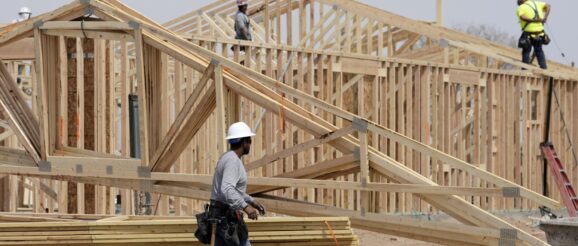Home sales and building slump in the face of uncertainty

In a May survey of builder confidence conducted by Wells Fargo and the National Association of Home Builders, home builder sentiment dropped to a level last seen in November 2023.
The result is a country where builders want to build, and buyers want to buy — but the future is too much in doubt.
Construction has slipped
The first issue is a dip in demand. Lots of Americans would love to buy a home, but they simply can’t afford to. Home prices are up nearly 50% since before the pandemic, and mortgage interest rates ticked up to 6.86% last week — a far cry from their pandemic low of 2.65% for a 30-year fixed-rate loan.

The median existing home sales price continued to climb nationally, to $414,000 — an all-time high for the month of April, and the 22nd consecutive month of year-over-year price increases.
Home sales remain at just 75% of pre-pandemic activity, says Lawrence Yun, chief economist of the National Association of Realtors, despite the U.S. adding millions of jobs.
“Pent-up housing demand continues to grow, though not realized,” Yun said in a statement accompanying April’s disappointing sales figures. “Any meaningful decline in mortgage rates will help release this demand.”
Then there’s the complicated outlook for supply.
Construction of single-family homes dropped in April, according to figures from the Census Bureau. Every indicator concerning single-family homes — building permits, starts of new homes, and completions — was down compared to a year ago. Permits for multi-unit buildings are also down more than 5% so far this year.
And in addition, “the tariff debate has created a lot of uncertainty,” says Robert Dietz, chief economist at the National Association of Home Builders.
There’s currently a 14.5% duty on that Canadian lumber (it was hiked from 8.05% last August). But further review from the Department of Commerce is coming, which could push that number higher. The cost of framing lumber is up about 16% over a year ago.
It’s worth noting that the U.S. Lumber Coalition disputes the notion that lumber tariffs are to blame for driving up home prices. The coalition accuses Canada of dumping excess supply into the U.S. market, and says that lumber accounts for less than 2% of the cost of building the average new home.
For its part, the NAHB says softwood accounts for about 6% of the cost of a single-family home, when lumber, panels and millwork are taken into account.
The average impact of all tariffs enacted or expected so far, including on lumber, is nearly $11,000 per single family home, says Dietz.

Joe Raedle/Getty Images/Getty Images North America
When costs are growing but builders can’t raise prices, housing production slows down.
And although the outlook for new home construction is cloudy, part of the issue for builders is that right now there are plenty of existing homes for sale. Many people listed their homes to sell in the last few months, pushing inventory more than 20% higher than a year ago.
That competition means it could be harder to sell new homes, and builders will have to cut prices. The May NAHB/Wells Fargo survey found that 34% of builders had cut prices during the month, up from 29% in April. Despite what Dietz called a “surprise” bounce in new home sales in April’s report, overall they are down over 1% this year to date.
Waiting it out
Many Americans had hoped to buy a home this spring, but have instead been stymied by concerns about a possible job loss, high mortgage rates, and stock market volatility. In short, many would-be buyers are finding reasons to wait.
One of them is 32-year-old Kassandra Ford, a biology professor.
After getting outbid twice — offering the asking price on one home, and $15,000 above asking on another — they decided to take a breather.
“I’m keeping an eye on Zillow, but unlike before, when I was probably looking every day, now it’s maybe once or twice a week,” says Ford. “It feels very much like we’re in a holding pattern.”
Instead of taking out a mortgage, Ford re-signed a lease on her two-bedroom apartment, and her mom moved in with her. “Especially with the economy, honestly, it’s going to be great to be able to have some shared expenses with somebody as well.”
They plan to try again to buy, in a different season. Until then, they’ll keep adding to their down payment fund.
“We’re just going to hold tight, hold on to what we have, and keep an eye on things,” says Ford.
